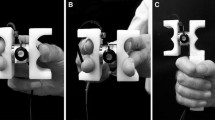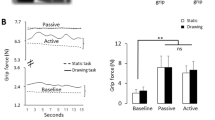Summary
During manipulation involving restraint of ‘active’ (mechanically unpredictable) objects, it is presumed that the control of the grip and other reaction forces more regularly relies on somatosensory input than during manipulation of ‘passive’ (mechanically predictable) objects. In companion studies we have shown that grip forces are automatically adjusted to the amplitude and the rate of distal pulling loads imposed through an ‘active’ object held in a precision grip. In this study anesthesia of either one or both digits holding the manipulandum was used to examine whether the grip force regulation was dependent on afferent signals from the digits. Five types of trapezoidal load force profiles of various rate and amplitude combinations were given in an unpredictable sequence while the subject was prevented from seeing the hand. Grip forces, load forces and position of the manipulandum in the pulling direction were recorded. With both digits anesthetized the load amplitude changes yielded considerably less grip force modulation and in many trials obvious grip force responses were absent. Moreover, the latencies between the onset of the load changes and the observed grip force responses were much prolonged. However, there was pronounced inter-individual variation. Subjects exhibiting a lower stiffness in the pulling direction, probably due to more flexed fingers when holding the manipulandum, showed a higher force modulation, higher responsiveness to the load ramps and shorter latencies. Hence, under certain conditions afferent input from receptors proximal to the digits could be utilized to provide some grip regulation. The evoked grip force responses showed an initial response similar to the normally occurring ‘catch-up’ response, but it was not graded by the load force rate. Also, there was no ‘tracking’ response, suggesting that the latter was contingent upon a momentto-moment control using afferent input from the digits. With only one digit anesthetized (thumb) the handicap was less severe. Thus, the grip force regulation was impaired under any condition of digital anesthesia, i.e., afferent input from both index finger and thumb was required for the adequate operation of the grip force regulation.
Similar content being viewed by others
References
Burke D, Gandevia SC, Macefield G (1988) Responses to passive movement of receptors in joint, skin and muscle of the human hand. J Physiol 402:347–361
Cole KJ, Abbs JH (1988) Grip force adjustments evoked by load force perturbations of grasped object. J Neurophysiol 60:1513–1522
Darton K, Lippold OCJ, Shahani M, Shahani U (1985) Long-latency spinal reflexes in humans. J Neurophysiol 53:1604–1618
Edin BB (1990) Finger joint movement sensitivity of non-cutaneous mechanoreceptive afferents in the human radial nerve. Exp Brain Res 82:417–422
Edin BB, Abbs JH (1991) Finger movement responses of cutaneous mechanoreceptors in the dorsal skin of the human hand. J Neurophysiol 65:651–670
Edin BB, Westling G, Johansson RS (1992) Independent control of human finger tip forces at individual digits during precision. J Physiol (London) (in press)
Evans AL, Harrison LM, Stephens JA (1989) Task-dependent changes in cutaneous reflexes recorded from various muscles controlling finger movement in man. J Physiol (Lond) 418:1–12
Flanders M, Cordo PJ, Anson JG (1986) Interactions between visually and kinesthetically triggered voluntary responses. J Motor Beh 18:427–448
Gandevia SC, McCloskey DI (1977) Effects of related sensory inputs on motor performance in man studied through changes in perceived heaviness. J. Physiol (Lond) 272:653–672
Garnett R, Stephens JA (1980) The reflex responses of single motor units in human first dorsal interosseous muscle following cutaneous afferent stimulation. J. Physiol (Lond) 303:351–364
Garnett R, Stephens JA (1981) Changes in the recruitment threshold of motor units produced by cutaneous stimulation in man. J Physiol (Lond) 311:463–473
Jeannerod M (1981) Intersegmental coordination during reaching at natural visual objects. In: Long J, Baddeley A (eds) Attention and performance. Erlbaum, Hilldale, NJ, pp 153–168
Jeannerod M (1986) The formation of finger grip during prehension. A cortically mediated visumotor pattern. Behav Brain Res 19:99–116
Jenner JR, Stephens JA (1982) Cutaneous reflex responses and their central nervous pathways studied in man. J Physiol (Lond) 333:405–419
Johansson RS (1991) How is grasping modified by somatosensory input? In: Humphrey DR, Freund HJ (eds) Motor control: concepts and issues. Dahlem Konferenzen. John Wiley & Sons Ltd, Chichester, pp 331–355
Johansson RS, Häger C, Riso R (1992b) Somatosensory control of precision grip during unpredictable pulling loads. II. Changes in load force rate. Exp Brain Res 89:192–203
Johansson RS, Riso R, Häger C, Bäckström L (1992a) Somatosensory control of precision grip during unpredictable pulling loads. I. Changes in load force amplitude. Exp Brain Res 89:181–191
Johansson RS, Vallbo ÅB (1979) Tactile sensibility in the human hand: relative and absolute densities of four types of mechanoreceptive units in the glabrous skin. J Physiol (Lond) 286:283–300
Johansson RS, Westling G (1984) Roles of glabrous skin receptors and sensorimotor memory in automatic control of precision grip when lifting rougher or more slippery objects. Exp Brain Res 56:550–564
Johansson RS, Westling G (1987) Signals in tactile afferents from the fingers eliciting adaptive motor responses during precision grip. Exp Brain Res 66:141–154
Johansson RS, Westling G (1988) Coordinated isometric muscle commands adequately and erroneously programmed for the weight during lifting task with precision grip. Exp Brain Res 71:59–71
Johansson RS, Westling G (1990) Tactile afferent signals in the control of precision grip. In: Jeannerod M (eds) Attention and performance, Vol XIII. Erlbaum, Hilldale, NJ, pp 677–713
Kanda K, Desmedt JE (1983) Cutaneous facilitation of large motor units and motor control of human fingers in precision grip. In: Desmedt JE (eds) Motor control mechanisms in health and disease. Raven, New York, pp 253–261
Lamarre Y, Chapman CE (1983) Fast ballistic arm movements triggered by visual, auditory and somesthetic stimuli in the monkey, activity of precentral cortical neurons. J Neurophysiol 50:1343–1358
Loo CKC, McCloskey DI (1985) Effects of prior instruction and anaesthesia on long-latency responses to stretch in the long flexor of the human thumb. J Physiol (Lond) 365:285–296
Marsden CD, Merton PA, Morton HB (1977) The sensory mechanism of servoaction in human muscle. J Physiol (Lond) 265:521–535
Marsden CD, Merton PA, Morton HB (1985) New observations on the human stretch reflex. J Physiol (Lond) 360:51P
Matthews PBC (1989) Long-latency stretch reflexes of two intrinsic muscles of the human hand analysed by cooling the arm. J Physiol (Lond) 419:519–538
Nashner LM (1981) Analysis of stance and posture in humans. In: Towe AL, Luschei ES (eds) Handbook of behavioral neurobiology: motor coordination, Vol 5. pp 527–561
Nickerson RS (1973) Intersensory facilitation of reaction time: Energy summation or preparation enhancement? Psychol Rev 80:489–509
Siegel S (1956) Nonparametric statistics for the behavioral sciences. McGraw-Hill, Tokyo
Westling G, Johansson RS (1984) Factors influencing the force control during precision grip. Exp Brain Res 53:277–284
Westling G, Johansson RS (1987) Responses in glabrous skin mechanoreceptors during precision grip in humans. Exp Brain Res 66:128–140
Author information
Authors and Affiliations
Rights and permissions
About this article
Cite this article
Johansson, R.S., Häger, C. & Bäckström, L. Somatosensory control of precision grip during unpredictable pulling loads. Exp Brain Res 89, 204–213 (1992). https://doi.org/10.1007/BF00229017
Received:
Accepted:
Issue Date:
DOI: https://doi.org/10.1007/BF00229017




